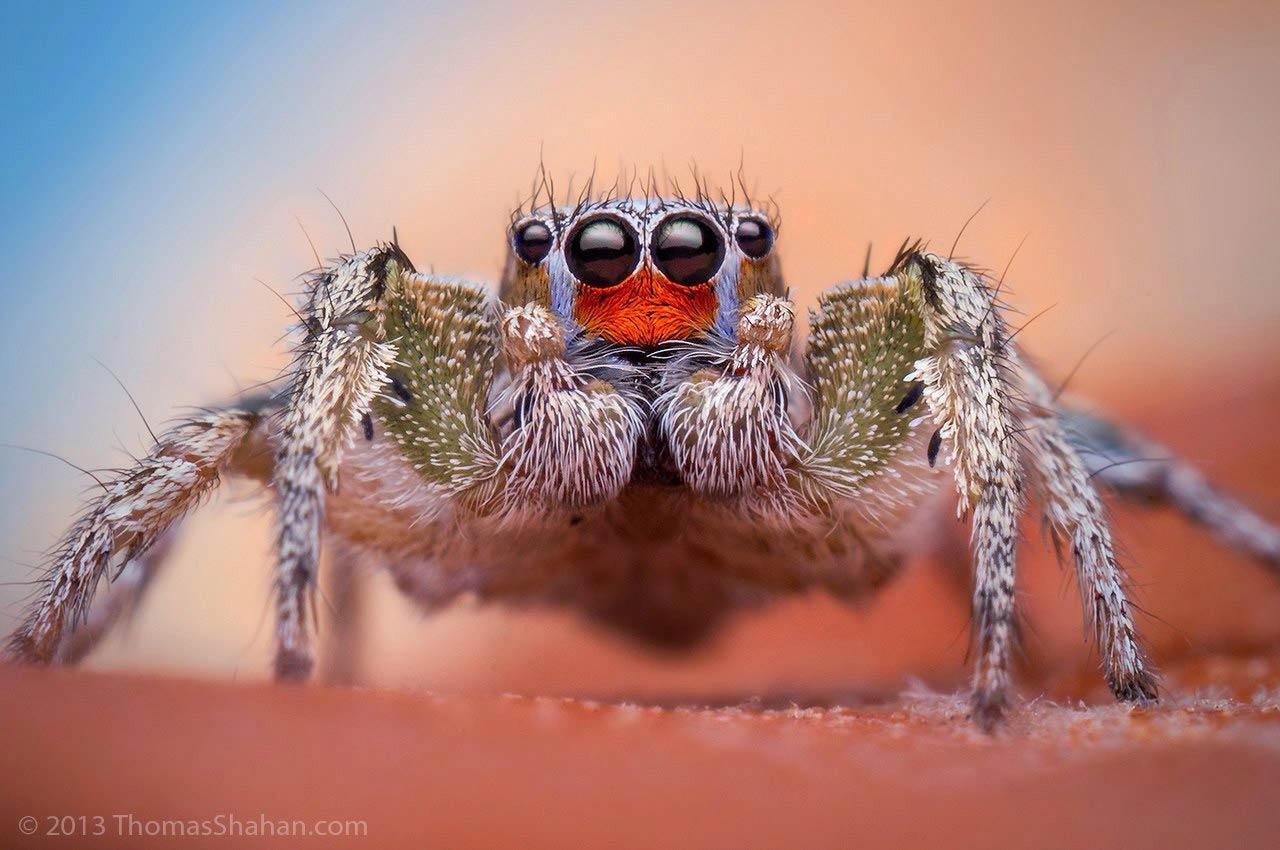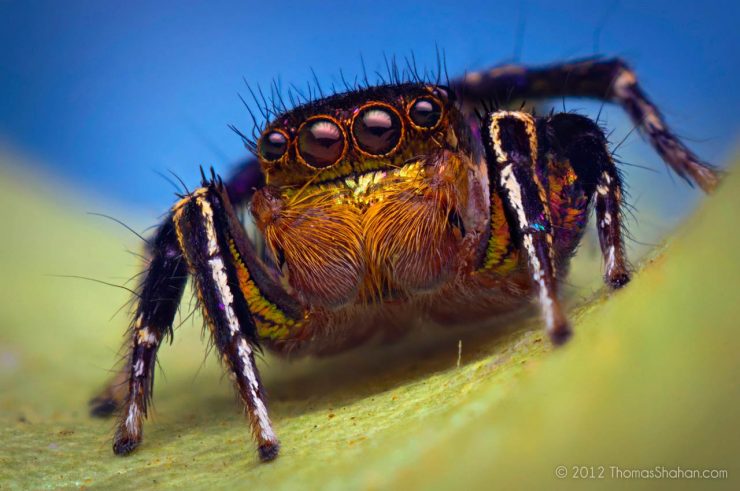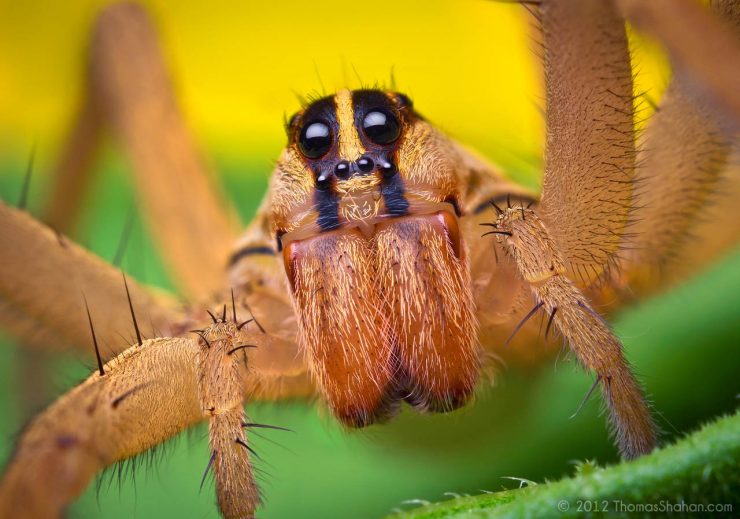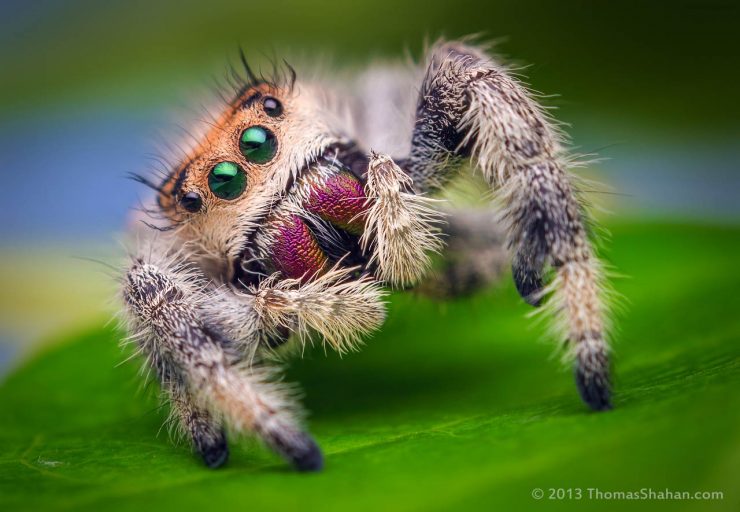
When most of us think of amazing wildlife photography, we think of African safaris involving massive, white telephoto lenses that cost as much as a car. Thomas Shahan has found another method, though, and his images are equally striking. His work has been featured in a variety of magazines and publications, including The National Geographic, Popular Photography, and NBC’s “Today Show”. Shahan’s techniques take some patience and persistence, but unlike that Canon 400mm f/2.8, the equipment involved is well within the reach of any photography enthusiast. Shahan’s work proves that ingenuity, persistence, patience, and a little artistic vision are more important than specific equipment when it comes to taking great macro photographs.
Shahan’s typical macro setup includes a consumer-level DSLR, a set of macro tubes, a lens-reversal adapter, an old 28 or 50mm manual-focus lens, a manual flash unit, and a home-made flash diffuser.
Thomas was kind enough to take time out from his busy day in Oregon to talk to Light & Matter last week.
JMG: For people who are interested in macro photography and want to try it themselves, what are your recommendations for equipment?
Shahan: My first advice would be not to go out and buy a lot of equipment. It seems like a lot of people, when they see photos of the jumping spiders online, think “I’ve got to get a digital SLR and a macro lens and a twin light setup and all this fancy equipment”, and that’s really not the case. It’s more valuable to get to know the actual arthropod that you’re interested in shooting, and just spending a little time thinking about what you want to do instead of investing in a lot of equipment off the bat. I’ve talked to so many people who go out and buy a bunch of equipment and they don’t know what to do with it, and they get disillusioned with the whole thing and give up.
Start by finding out what you can do with the equipment you already have, even if that’s an iPhone or a point and shoot. They make little “macro” lens attachments… they look kinda like “Livestrong” bracelets, with a little lens embedded in in an elastic band that fits over your iPhone… I’ve seen some great photos taken with those. There’s a company called Raynox that sells a close up filter for any lens and they work well on point and shoots. Sometimes I’m jealous of people who can do that, they put a little lens on their point and shoot and can take excellent, excellent photos.
JMG: And for photographers that already have a DSLR?
Shahan: I’ve never owned a macro lens. I’ve never really needed to buy one because I’ve always found other solutions that suit the type of photography that I do, though there are some limitations to the types of lens setup that I use. If people have a digital SLR and they’re just getting interested in macro photography, I’ve seen some really great photos taken with the kit lens, something like an 18-55mm using a macro-reversing ring, which allows them to pop on the kit lens that they already have but mounted backwards. If you have a 50mm lens, I find that that’s really well suited to macro photography; they’re sharp and give you a good working distance. So, for people who are looking for a budget macro setup, I’d recommend a set of extension tubes and a 50mm lens popped on backwards with the reversing rings, and you know… a cheap set of extension tubes is $12, and a reversing ring is another $10, so with a little over $20 you can take some great shots.
JMG: Canon AF lenses (and many Nikon AF lenses) don’t have aperture control rings on them, and when they’re reversed, you have to shoot them wide open, which would be problematic when it comes to depth of field; what do you do about that?
Shahan: For my work, I’ve gone for older lenses that have a manual aperture ring, and I shoot with them already stopped down. That makes for a really dark viewfinder, which makes focusing difficult, so you can use some auxiliary lighting or think ahead and shoot at certain times of day… it’s perfectly doable. Older lenses are also cheaper.
I don’t own a single autofocus or auto-metering lens. Older lenses are a lot better suited for the type of lens-reversal that I do.
[Since reverse-mounted lenses don’t use the lens mount to attach to the camera, you can buy any lens brand that you feel like. On Ebay, they can be found anywhere between $20 and $100, or more, but you may be able to find better deals locally on Craigslist or in thrift shops. – JMG]
JMG: You shoot hand held most of the time.
Shahan: Yes, I don’t own a tripod.
JMG: The standard practice is that if you shoot macro, you shoot from a tripod…
Shahan: Yeah, and that’s what I tell people not to do. Get off the tripod!
JMG: How is it that you produce such sharp images without using a tripod?
Shahan: It’s really really simple. Every single shot that you see that I’ve ever taken was taken with a flash within about 4 inches of the subject. On all my shots, I’ve probably taken them with an exposure of 1/200th or 1/250th sec, which for macro photography, is relatively slow. With natural light, I’d be shaking all over the place, but the duration of a flash pop is much much faster than the actual shutter speed. Usually when I take a shot, the subject is actually cast in a shadow, so the only light source on the subject is from the flash; if you see colors in the background, sometimes that’s natural light creeping through, like the blue from the sky. So the reason why I can shoot handheld and not have shaky photos is the flash. If you use the flash as your primary light source it freezes things, so if a jumping spider were jumping at the camera and I caught it with the flash, that spider would be frozen in mid-air, regardless of the shutter speed.
[If your lens’ aperture is stopped down enough that the flash is the only light contributing to the exposure, then the duration of the flash becomes the effective shutter speed, even if the actual shutter speed is longer. Since any light other than the flash coming through the lens is not bright enough to form an image, it’s as if the shutter is closed during that time anyway. On most flash units, the duration of a flash is between 1/1000th and 1/128,000ths sec., much faster than any mechanical shutter in an SLR. – JMG ]
JGM: So tell me a bit about a typical day of shooting for you. Do you go out hunting for a particular subject? Do you just go out and see what you find?
Shahan: I go out for anywhere from 5-10 hours a day to certain areas where I’ve had luck finding interesting subjects before, usually spring to fall in Oklahoma. I just go out with my camera and take thousands upon thousands of photographs, and sometimes I’ll get lucky; maybe I’d find a jumping spider on a rock and I’ll lift that rock up to the sun and shoot right into its face and get the shot that I’m looking for, and I’ll be ecstatic and go home and process it and post it, but more often than not, I’ll go out for weeks and weeks at a time, and they’ll all be green or blue or out of focus or my flash isn’t popping. My success rate is very low; for every 99 shots i take, 1 is O.K., and for every 1000 shots, there’s one that I’d be proud of. Given that I’m using a home-made flash and modified extension tubes and backwards lens… it’s a pain in the ass to shoot. I’ve gotten sunburned, its really sweaty, and it can be boring work, but it makes the reward for finding that one species that I’ve been looking for for 3 years that much more rewarding. There are certain species that I go out looking for… I’ll hunt for specific spiders.
JMG: What kind of post processing do you do?
Shahan: My usual workflow has been that I shoot JPG and then just process them directly in Photoshop. Usually my processing entails cropping. I tend to crop things quite a bit, because these are going to be posted online, and I don’t feel any obligation to display the full frame…it doesn’t matter… I just want to get as close as possible so that the largest number of people possible see this species that I’m excited about so they’ll click on it. The main thing that I care about is, “How will this shot look in a thumbnail? Will people click on this more than the next guy’s shot?” It’s not for me, there’s no personal gain for me as the photographer… you know, I don’t consider photography art… I don’t give a shit what people think, whether people think I’m a good photographer or not, I really want people to like jumping spiders! Jumping spiders are beautiful, amazing, really impressive little animals, and I feel this drive to do PR work for them. I want to take these “Glamour Shots” of them! For me it’s more about propaganda than photography. If somebody says, this is a beautiful photograph, what they’re really saying is “This is a beautiful spider!” And I didn’t make that spider, I didn’t paint that spider. I can’t take credit for the spider’s beauty, so therefore, I have a hard time calling this type of photography art, because when the source of the beauty, the source of the wonder and excitement for the viewer comes from the subject, it’s almost insulting to place that awe on the photographer and say, “Thomas Shahan is a great photographer.” No, Thomas Shahan finds cool spiders. That’s a better way to word it.
JMG: You know, its funny that you mention that, because I’ve looked at a lot of macro photos of insects, arthropods, other invertebrates, etc, and the fact is that some of the photos are decent, and some of them are truly gorgeous. Some of them are better composed, for example, and it’s certain photographers who do this consistently, so I’m inclined to attribute that difference to the artistic interpretation of the photographer. I know that you have a background in art, I was going to ask you how your background in art influences your photography?
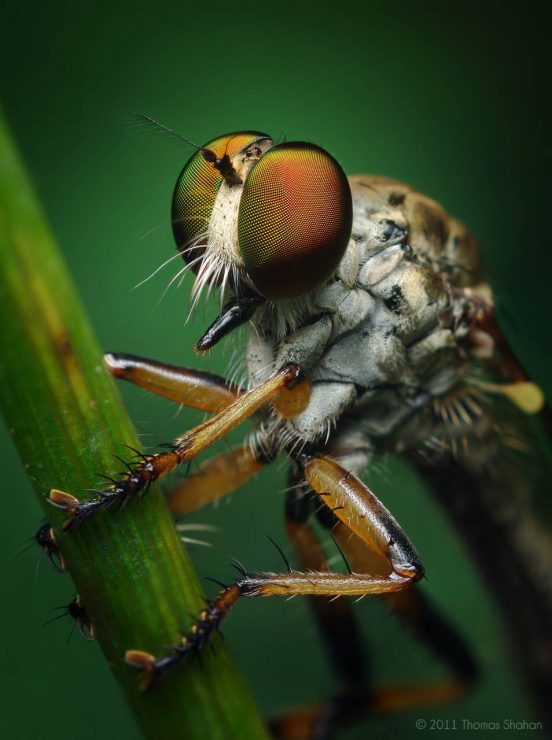
Shahan: Well, my background in art, and my understanding of composition, color… what’s going to catch people’s eye… this inherent design sense that’s been nailed into me through being involved in actually making physical art, is definitely manifested in the photographs that I take. I mean, I know vibrant colors and high contrast are going to capture more people’s attention than a washed out photograph of a brown recluse’s abdomen.
People are going to want to see big, glossy, anthropomorphic eyes. You know, it’s been more helpful for me to watch Disney movies, in that regard, than for me to study entomology to promote these arthropods. So, yeah, my background in art has definitely influenced my work, and I make artistic interpretations. For example, if I have a warm colored spider, I’ll put it on a cool background so that it pops out from the background. These are just tricks that help me display these spiders in a better way, so O.K…. you know, due to my stagings, and angles, and lighting and everything, I’m doing the best to make these beautiful spiders look their best, so that more people appreciate them. So I guess there are artistic elements that go into it, but for me, the final thing is that it’s a beautiful spider, and maybe it’s a technically interesting photograph, but I just have a hard time calling the types of photographs that I take “art”. But I’m not a stickler about it. I really don’t care. People can say what they want.
Back to your question about post processing, I’ll bring them into Photoshop… I’m not very careful with my equipment, so I’ll often have a lot of dust on my sensor. Often what I’ll do is remove dust from the image, but I’ll never remove sensor dust if it’s actually on the in-focus subject. So, if it looks like there’s a little hair in the top left of the frame, solid green out of focus background… yeah, I’ll take that out. But if there’s a big glob of dust obscuring one of the eyes of the jumping spider, no… fuck it. I’m just going to have to take another photograph, cause that one’s a bummer. So, I never actually edit the subject.

